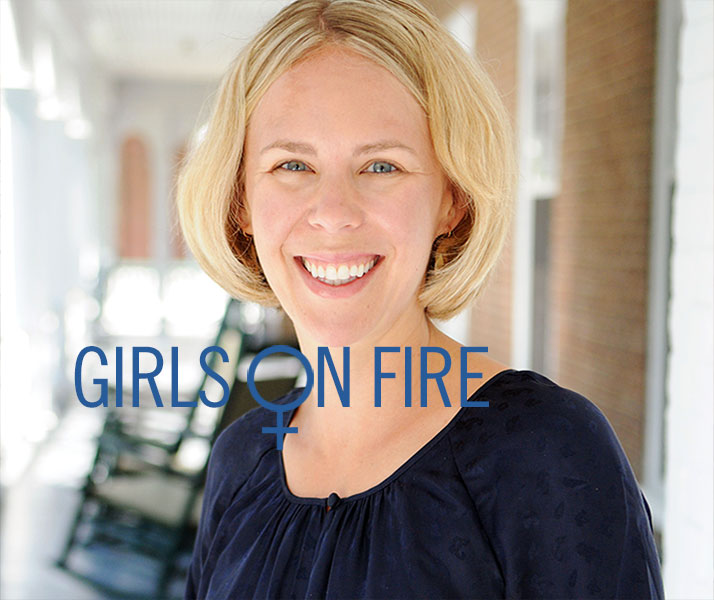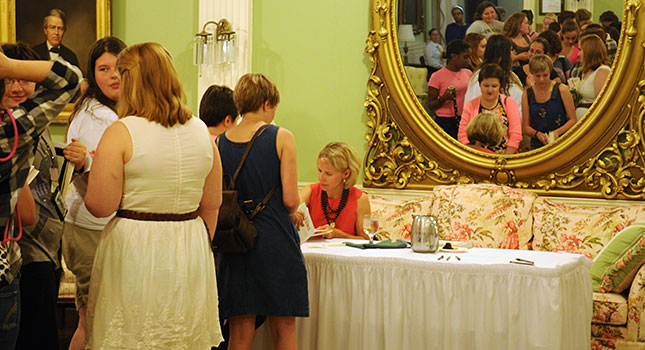
Girls on Fire

Atwell signing copies of her book for students standing in a line that stretched through the Green Drawing Room. Photo: Trudy Stevens ’14.
Mary Stewart “Polly” Atwell ’00 visited campus in September for a campus-wide discussion of her first novel, Wild Girls,* this year’s common reading.
During her visit, Atwell also met with Professor of English Julie Pfeiffer and four members of the first-year class (Taylor Humin, Angie Crews, Diana Foronda, and Moira Bailey) for a more intimate conversation, part of which is transcribed here.
*From the jacket: Kate Riordan fears two things as she grows up in the small Appalachian town of Swan River: that she’ll be a frustrated townie forever or that she’ll turn into one of the mysterious and terrifying wild girls, killers who start fires and menace the community.
PFEIFFER: Maybe you could start, Polly, by talking about what it was like for you in your first week or two at Hollins?
ATWELL: I remember it being kind of bewildering. I guess what stands out for me is meeting people in the first couple of weeks, people who became my best friends, people who I know now through the alumnae network. Of course you don’t know that these people are going to be important to you, but just because of the intimacy of Hollins you get to start forging those relationships right away. So it was a good time and an exciting time, but a little terrifying. It has to be for everybody, right?
HUMIN: I’m just surprised how close everyone has gotten so quickly. It’s crazy to think that we’ve only been here for a matter of days, but already we’re all starting to get used to living with each other and being close all the time. It’s weird to think that people who are suddenly becoming our new friends are going to be in our lives for the next four years and probably far beyond.
ATWELL: Absolutely, probably the best friends you’ll make and it’s funny to think about now, when you’re just at the beginning.
PFEIFFER: Taylor, you said something in discussion a week ago about Kate [the novel’s main character] being in a liminal space that felt relevant to your experience this summer.
HUMIN: I appreciated reading this book because I could definitely relate to Kate feeling really nervous about the future and about having to make a big leap of change in her life. She desires throughout the novel to leave Swan River, but when her leaving comes closer and closer she starts feeling very restless and I think that was a really strong feeling [for me] this summer. I was waiting for when I could start setting things on fire: Do I feel restless enough yet? Is it time to start torching things? But I definitely could relate to what Kate was feeling about being nervous, while also being excited and not really being sure how to balance that out.
ATWELL: When my agent was shopping the book around, the reason I chose the editor I did at Scribner was when I talked to her she said, “I really see this as a feminist allegory.” I said, “Me too—that’s great.” It’s all about choice and having circumstances force on you some choices that are not positive and some that will take you in a positive direction—and being able to make that decision for yourself.
FORONDA: What inspired you to do this novel? I mean, was it Hollins? [Laughter] Both the Academy and Hollins are women’s schools and yet I don’t see any fire or burning places on campus yet.
ATWELL: I was really afraid of that because the landscape is very much like Hollins, which I love. And I thought, “Oh, I hope that nobody thinks I’m saying all these terrible things about Hollins.”
CREWS: That’s what I was thinking. I was like, “Is this supposed to be Hollins? Is this a reflection of Hollins? I’m a little afraid.”
ATWELL: I’m here to tell you it’s not like that. I’d gone to boarding school before I came to Hollins, and even though the landscape ended up being more based on this place, my experience of being at boarding school and just being so tightly isolated with the same people for years really did lead into the book to a certain extent. I think close, wonderful relationships can form in that type of environment, but it can also be a very bad thing if you get the wrong personalities together. So I tried writing about it in a realistic way about girls at a boarding school and it didn’t really work. It was when I had this idea of exaggerating their power, giving them the ability to do things that we would never expect in the real world that it kind of clicked as a story, and then I got to write about female empowerment in a way that was interesting to me. Some of my good friends from Hollins came down this weekend and they had all read the book. They kept saying, “You’re so dark, I never knew you were so dark.” I don’t really see it that way. I just felt like it was a good story to tell.
PFEIFFER: When I read the blurb on the back of the book I thought, “Oh dear, I’m not going to like this.” But it turns out to be dark without being gory. Maybe because of the allegory, I’m not in the woods feeling the fear of these girls’ victims. Maybe because we enter this story through Kate and she’s writing about these events after the fact, there is a sense of control. Kate’s telling us something about her past that helps us understand what it’s like to be an adolescent girl in this society. But there’s that little bit of detachment through the first-person narrator who has survived this experience. I appreciated that.
ATWELL: I’m glad you felt that way. To me, I wanted the fantasy and the darkness to be really subordinated to her journey into the characters. A question I get a lot is, “Do you want to write more fantasy?” I really don’t think I will. To me the allegory was what was interesting here.
[hr]
A long version of Julie Pfeiffer’s “Wild Girls” class is available for download (PDF).
